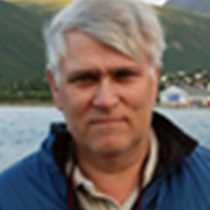Hellmobotyn, Tysfjord
As we woke up this morning, our captain and his crew had taken the National Geographic Explorer into the fjord Tysfjord, and made a remarkable close to beach anchoring.
Tysfjord is known for its herring-feeding orcas, although they are only here during fall as nights turn long and days start to get short, to feed on the spawning herring. We had a different agenda for the day. Now it is summer here in Arctic Scandinavia, and flowers and birdlife are in their peak with 24 hours of daylight.
At one of the many fingers to the fjord, Hellmobotyn, you find a small Sami fishing settlement. We are now in Lappland and the reindeer-herding Samis are the indigenous people. Lappland covers four different nations: Norway, Sweden, Finland and parts of the Kola Peninsula in western Russia. Exactly when the Sami people arrived to northern Scandinavia, no one knows, but they are related to Nentes and other reindeer-herding tribes along the northern belt of the taiga forest in Russia and further on east in Siberia.
Here along coastal northern Norway, some more or less gave up herding reindeer and became fishermen instead, as the surrounding waters are extremely rich for fish. They call themselves Sami, but sometimes in the south are referred to as Lapps. This camp we walked through along the beach at Hellmobotyn is only active in late summer and through the fall as the salmon runs the river and also the “arctic gold” is accessible, the cloudberry (Rubus chamaemorus).
If you look on a map of the Scandinavian Peninsula, you will find Norway stretching southwest/northeast and, in the area we sail today, it is a very narrow nation.
From the Zodiac landing site and along the trail towards the border with Sweden, only a 5- to 6-hour hike away, we first walked in typical taiga forest. The taiga forest is the world’s largest forest and stretches from the Atlantic coast in Norway all the way to the sea of Okhotsk in eastern Siberia. Here in the western part of the taiga forest, two coniferous trees occur, Scottish Pine and Norwegian Spruce. You also find large areas with birch trees, willow (Salix sp.), a few Mountain Ash and, in more fertile and protected areas, Aspen trees.
Long hikers made it up into the mountains, beyond the tree limit, and went past huge waterfalls. Lots of meltwater is heading down towards the sea as the snow melting now in the mountains is intense.
Medium hikers made it up to the granite plateaus and saw along the trail plenty of flowers in full bloom. For those preferring to stay at sea level, Zodiac cruises and kayaking were options. Northern Scandinavia is by far the largest wilderness area still existing in Europe and to have the pleasure to explore this today is always a highlight.
The afternoon was used to slowly cruise through the fjord landscape heading north towards the Arctic gateway, Tromso.
Our day today was our very last to explore the fjord landscape of coastal Norway. Two days ago we crossed the Arctic Circle and soon we are heading much further north, to the cold High Arctic latitudes.
Surprising enough, now already way beyond the circle as we sailed through the fjords, we saw plenty of small farms. It is the Gulf Steam which brings energy all the way from the Gulf of Mexico to this part of the world and makes it prosperous.




